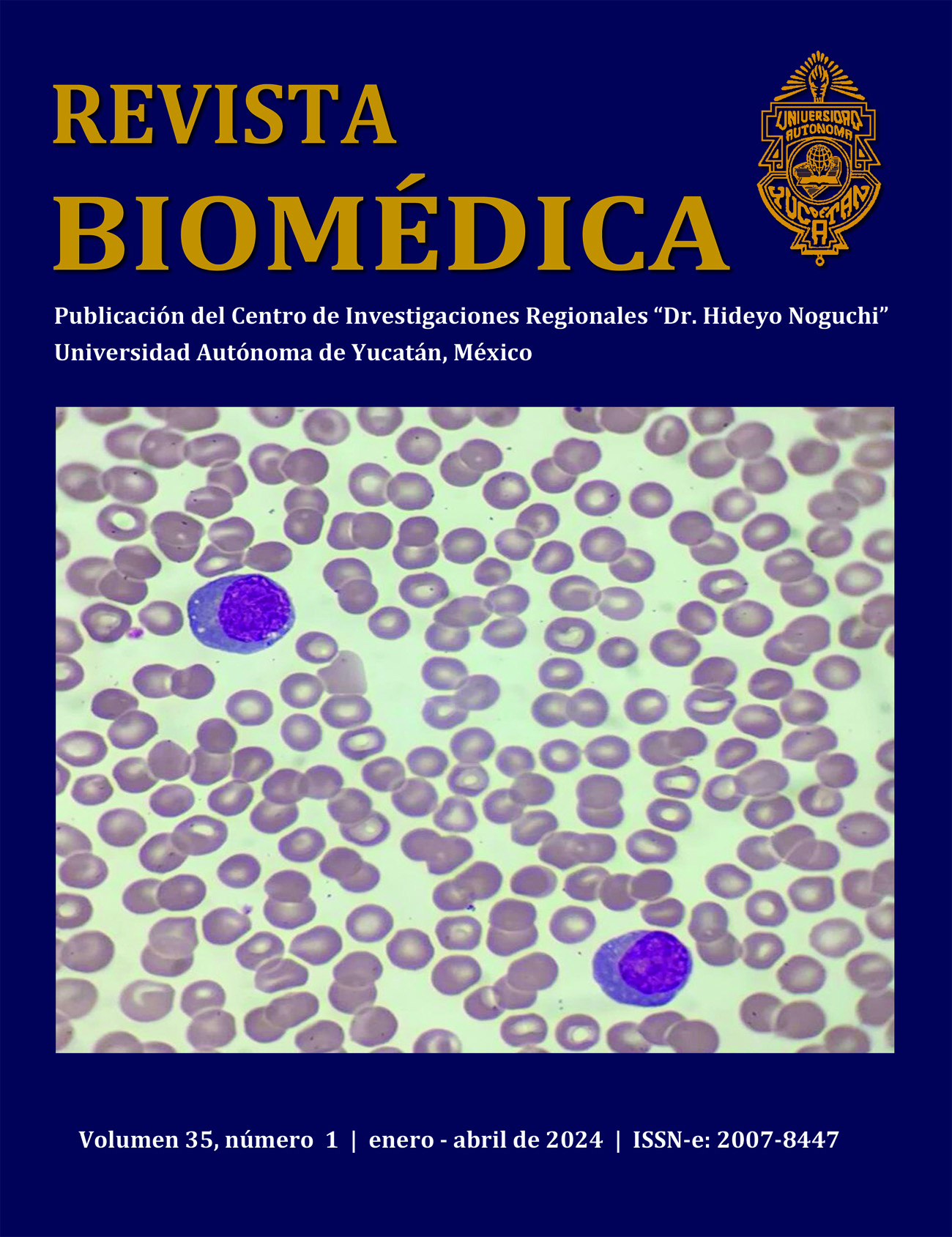Evaluación de actividad de la enzima arginasa en pacientes con diabetes mellitus en Veracruz, México.
Resumen
Introducción. La diabetes mellitus (DM) es una enfermedad crónica que incrementa su frecuencia cada año, y la búsqueda de estrategias que sean de ayuda en la prevención o control son el objetivo en diversos estudios. La DM puede disminuir la biodisponibilidad de óxido nítrico (ON) mediante diversos mecanismos, presentándose la disfunción endotelial. Diversos estudios en modelos animales y estudios in vitro sugieren la participación de arginasa en la DM, al ser un competidor directo por el sustrato de la sintasa de óxido nítrico (NOs), disminuyendo la producción de ON.
Objetivo. En este estudio, se determinó en pacientes con DM la actividad de la enzima arginasa como un posible marcador del progreso de la enfermedad.
Material y Método: Se llevó a cabo un estudio transversal, en el que se utilizaron muestras sanguíneas en ayuno de 12 horas, se determinaron los parámetros antropométricos, los niveles de glucosa, colesterol y se evaluó la actividad de arginasa.
Resultados y conclusiones: Participaron 107 pacientes en total, 37 controles y 67 con DM. Los resultados encontrados sugieren que la actividad de la arginasa no tiene un papel como marcador de la enfermedad en pacientes con DM que no presentan signos de enfermedad avanzada.
Referencias
OMS (Organización Mundial de la Salud). Prevalencia de la diabetes y de los factores de riesgo conexos en México. 1. 2016;1. 2. Lamuchi-Deli N, Aberomand M, Babaahmadi-Rezaei H, Mohammadzadeh G. Effects of the hydroalcoholic extract of Zingiber officinale on arginase i activity and expression in the retina of streptozotocin-induced diabetic rats. Int J Endocrinol Metab. 2017;15(2): 1-7. DOI: 10.5812/ijem.42161 3. Shi Y, Vanhoutte PM. Macro- and microvascular endothelial dysfunction in diabetes. J Diabetes [Internet]. 2017;9(5):434–49. Available from: http://doi.wiley.com/10.1111/1753-0407.12521 4. Caldwell RB, Toque HA, Narayanan SP, Caldwell RW. Arginase: An old enzyme with new tricks. Trends Pharmacol Sci. 2015;36(6):395–405. DOI: 10.1016/j.tips.2015.03.006. 5. Durante W, Johnson FK, Johnson RA. Arginase: a critical regulator of nitric oxide synthesis and vascular function. Clin Exp Pharmacol Physiol. 2007;34(9):906–11. DOI: 10.1111/j.1440-1681.2007.04638.x . 6. Lange PS, Langley B, Lu P, Ratan RR. Novel roles for arginase in cell survival, regeneration, and translation in the central nervous system. J Nutr. 2004;134(10 Suppl):2812S–2817S; discussion 2818S–2819S. DOI: 134/10/2812S [pii]. 7. Li H, Meininger CJ, Hawker JR, Haynes TE, Kepka-Lenhart D, Mistry SK, et al. Regulatory role of arginase I and II in nitric oxide, polyamine, and proline syntheses in endothelial cells. Am J Physiol Endocrinol Metab. 2001;280(1):E75-82. DOI: doi.org/10.1152/ajpendo.2001.280.1.E75. 8. Qin Z, Hou X, Weisbrod RM, Seta F, Cohen RA, Tong X. Nox2 mediates high fat high sucrose diet-induced nitric oxide dysfunction and inflammation in aortic smooth muscle cells. J Mol Cell Cardiol. 2014;72:56–63. DOI: 10.1016/j.yjmcc.2014.02.019. 9. Shemyakin A, Kövamees O, Rafnsson A, Böhm F, Svenarud P, Settergren M, et al. Arginase inhibition improves endothelial function in patients with coronary artery disease and type 2 diabetes mellitus. Circulation. 2012;126(25):2943–50. DOI: 10.1161/CIRCULATIONAHA.112.140335. 10. Shatanawi A, Romero M, Iddings J, Chandra S, Umapathy N, Verin A, et al. Angiotensin II-induced vascular endothelial dysfunction through RhoA/Rho kinase/p38 mitogen-activated protein kinase/arginase pathway. Am J Physiol Cell Physiol. 2011;300(5):C1181-92. DOI: 10.1152/ajpcell.00328.2010. 11. Patel C, Rojas M, Narayanan SP, Zhang W, Xu Z, Lemtalsi T, et al. Arginase as a mediator of diabetic retinopathy. Front Immunol. 2013;4:1–11. DOI: 10.1152/ajpcell.00328.2010. 12. Chandra S, Romero MJ, Shatanawi A, Alkilany AM, Caldwell RB, Caldwell RW. Oxidative species increase arginase activity in endothelial cells through the RhoA/Rho kinase pathway. Br J Pharmacol. 2012;165(2):506–19. DOI: 10.1111/j.1476-5381.2011.01584.x 13. Kövamees O, Shemyakin A, Checa A, Wheelock CE, Lundberg JO, Östenson CG et al. Arginase Inhibition Improves Microvascular Endothelial Function in Patients With Type 2 Diabetes Mellitus. J Clin Endocrinol Metab, 2016, 101(11):3952–58. 14. Corraliza IM, Campo ML, Soler G, Modolell M. Determination of arginase activity in macrophages: a micromethod. J Immunol Methods. 1994;174(1–2):231–5. DOI: 10.1016/0022-1759(94)90027-2. 15. Lowry OH, Rosebrough NJ, Farr AL, Randall RJ. Protein measurement with the Folin phenol reagent. J Biol Chem. 1951;193(1):265–75. 16. Morris SM, Gao T, Cooper TK, Kepka-Lenhart D, Awad AS. Arginase-2 mediates diabetic renal injury. Diabetes. 2011; 60(11):3015–22. DOI: 10.1016/0304-3894(92)87011-4. 17. Paneni F, Beckman JA, Creager MA, Cosentino F. Diabetes and vascular disease: Pathophysiology, clinical consequences, and medical therapy. Eur Heart J. 2013; 34(31):2436-43. doi: 10.1093/eurheartj/eht149. 18. Yao L, Chandra S, Toque HA, Bhatta A, Rojas M, Caldwell RB, et al. Prevention of diabetes-induced arginase activation and vascular dysfunction by Rho kinase (ROCK) knockout. Cardiovasc Res. 2013; 97(3):509–19. DOI: 10.1093/cvr/cvs371. 19. Jung C, Figulla HR, Lichtenauer M, Franz M, Pernow J. Increased levels of circulating arginase I in overweight compared to normal weight adolescents. Pediatr Diabetes. 2014;15(1):51–6. DOI: 10.1111/pedi.12054. 20. Kashyap SR, Lara A, Zhang R, Park YM, DeFronzo RA. Insulin reduces plasma arginase activity in type 2 diabetic patients. Diabetes Care. 2008; 31(1):134–9. DOI: 10.2337/dc07-1198. 21. Morris CR, Poljakovic M, Lavrisha L, Machado L, Kuypers FA, Morris SM. Decreased Arginine Bioavailability and Increased Serum Arginase Activity in Asthma. Am J Respir Crit Care Med. 2004; 170(2):148–53. DOI: 10.1164/rccm.200309-1304OC. 22. Gálvan MF, Calderón JV, Intrago M, Torres A, Zamarripa R, Meléndez CD, et al. Oxidative stress in patients with different clinical expression of metabolic syndrome.Med Int Méx. 2014; 30(6): 651-659. 23. Tsao CF, Huang WT, Liu TT, Wang PW, Liou CW, Lin TK. Expression of high-mobility group box protein 1 in diabetic foot atherogenesis. Genet.Mol.Res. 2015; 14 (2): 4521-4531. DOI: 10.4238/2015.May.4.10. 24. Dimitriades V, Rodriguez PC, Zabaleta J, Ochoa A. Arginase I levels are decreased in the plasma of pediatric patients with Atopic Dermatitis. Ann Allergy Asthma Immunol. 2014; 113(3): 271–275. Doi: 10.1016/j.anai.2014.06.010. 25. González JA, Olivares IM, Tovar JM, Hernández NA, Méndez E, Ceballos GM, García JR. Influence of the AT2 receptor on the L-arginine–nitric oxide pathway and effects of (-)-epicatechin on HUVECs from women with preeclampsia. Journal of Human Hypertension 2013; (27) 355–361.
Enlaces refback
- No hay ningún enlace refback.













